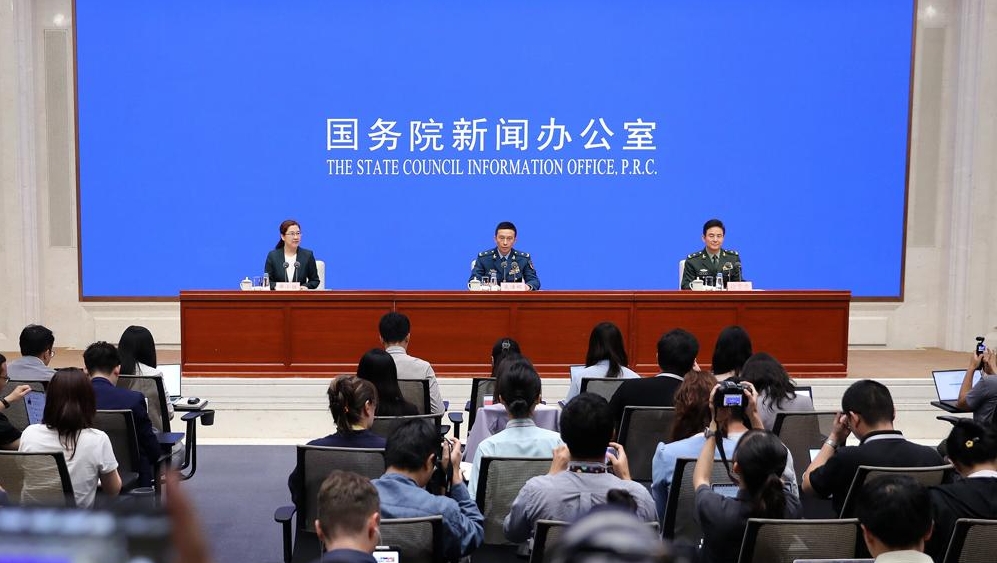Xu Guizhong:
Good afternoon. It's my pleasure to present the details of the military parade to you all.
The CPC Central Committee and the Central Military Commission decided to organize a parade to commemorate the 80th anniversary of the victory in the Chinese People's War of Resistance Against Japanese Aggression and the World Anti-Fascist War. The troops are highly enthusiastic about participating. Every officer and soldier takes pride in participating and being reviewed, and looks forward to being reviewed by the CPC Central Committee, President Xi, and the entire nation at this solemn moment, showcasing the heroic and majestic appearance of the people's armed forces as a force of peace, justice, strength and victory.
Mr. Wu just briefed us on the parade design details. I believe all of you can appreciate that this parade has many innovative elements and new features. The participating officers and soldiers represent various military units, and the proportion of new weapons and equipment making their debut is very high. Moreover, most of the armored columns and aerial echelons will be composed of mixed units. All of these factors have placed very high demands on this year's parade training and logistics support.
The parade involves more than 10,000 people, hundreds of aircraft, and hundreds of pieces of ground equipment. Achieving perfect uniformity, precise coordination, and split-second timing is comparable to organizing a military campaign. The overall planning, preparation and organizational command of the parade has required scientific training and thorough support. In conducting parade training, we have mainly focused on several key points: The first has been maintaining real combat standards. We have insisted on taking the parade preparation as an opportunity to strengthen the combat readiness of officers and soldiers and test the command, coordination and support capabilities of the troops. We have relied on the wartime command system to direct parade operations and have used combat simulation methods to develop and refine operational plans. Troops immediately began high-intensity training in accordance with parade standards upon receiving their gear, particularly for new equipment. The preparation process itself has functioned as a capability-building process. Second, we have emphasized scientific training methods. This parade has had a shorter preparation time than previous ones, and the participating troops have numerous other duties. Therefore, within our limited timeframe, we have focused on using systems such as BeiDou positioning, intelligent evaluation and simulation technologies to support basic training, formation drills, air-ground coordination exercises, complex scenario training, emergency response training, and training evaluation and assessment. The results have been excellent, saving us training time while improving training quality and efficiency. Third, we have focused on inspiring training motivation. We have emphasized leveraging the spirit of the resistance against Japanese aggression to reinforce historical duty, using the honor of being reviewed to fuel political enthusiasm, and drawing on the traditions of heroic and exemplary units to encourage high morale. Particularly after the announcement of the parade on June 24, relevant provinces have expressed care and support for the participating officers and soldiers, with extensive visits and consolation activities widely conducted around Army Day (Aug. 1). This has greatly encouraged the participating personnel and enhanced their sense of honor and responsibility. At the bustling training grounds, we have seen the glorious traditions and fine conduct of our Party and army being passed down and carried forward by this new generation of young officers and soldiers.
Since the 18th CPC National Congress, the logistics and equipment support capabilities of the military have achieved leapfrog development, effectively supporting the army's combat readiness. This progress is clear for all to see. This parade preparation, whether it's the training and daily life of participating personnel or the maintenance and upkeep of equipment, requires strong logistical support. Throughout our work, we have mainly concentrated on several key points: First, we have emphasized leveraging the advantages of joint logistics. Following joint operations and joint support requirements, we have fully relied on the regional joint logistics support system to provide precise and effective support for the parade. Second, we have focused on strengthening the management and support of new equipment. The equipment participating in this parade involves hundreds of different models and types. In accordance with wartime requirements, we assembled lean support forces, with joint equipment support extending to the tactical level, providing full-process, efficient support for high-intensity, fast-paced training operations. Third, we have focused on cost-effectiveness and operating practically and efficiently. Following the principle of diligence and cost-effective military development, we have made full use of existing training grounds and logistical conditions for preparations, achieving maximum resource efficiency and substantially cutting related expenses.
Judging from the recent rehearsal, the troops are basically ready for the parade. We believe that under the strong leadership of the CPC Central Committee, the Central Military Commission and President Xi, all participating troops will meet the highest standards in carrying out their parade responsibilities and provide a satisfactory performance for the Party and the people. Let us look forward to that day. That's all for my introduction. Thank you!
Shou Xiaoli:
The floor is now open to questions. Please raise your hands if you have questions and identify your news organization before raising questions.


 Share:
Share: 




 京公網(wǎng)安備 11010802027341號
京公網(wǎng)安備 11010802027341號